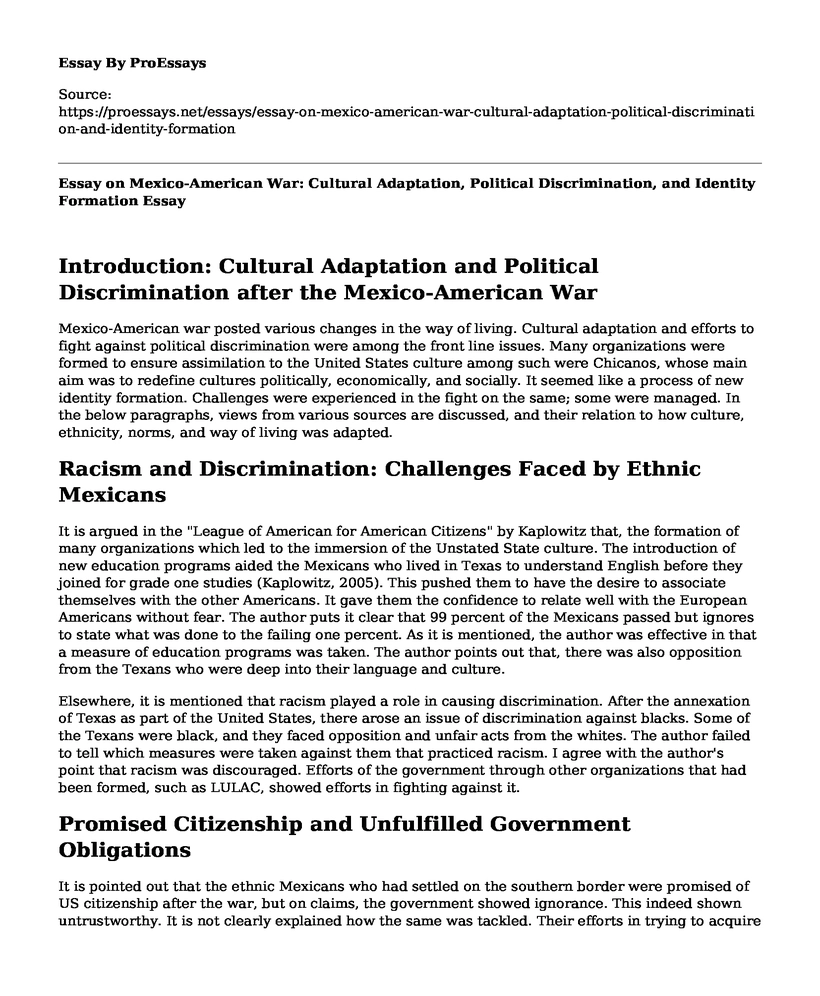Introduction: Cultural Adaptation and Political Discrimination after the Mexico-American War
Mexico-American war posted various changes in the way of living. Cultural adaptation and efforts to fight against political discrimination were among the front line issues. Many organizations were formed to ensure assimilation to the United States culture among such were Chicanos, whose main aim was to redefine cultures politically, economically, and socially. It seemed like a process of new identity formation. Challenges were experienced in the fight on the same; some were managed. In the below paragraphs, views from various sources are discussed, and their relation to how culture, ethnicity, norms, and way of living was adapted.
Racism and Discrimination: Challenges Faced by Ethnic Mexicans
It is argued in the "League of American for American Citizens" by Kaplowitz that, the formation of many organizations which led to the immersion of the Unstated State culture. The introduction of new education programs aided the Mexicans who lived in Texas to understand English before they joined for grade one studies (Kaplowitz, 2005). This pushed them to have the desire to associate themselves with the other Americans. It gave them the confidence to relate well with the European Americans without fear. The author puts it clear that 99 percent of the Mexicans passed but ignores to state what was done to the failing one percent. As it is mentioned, the author was effective in that a measure of education programs was taken. The author points out that, there was also opposition from the Texans who were deep into their language and culture.
Elsewhere, it is mentioned that racism played a role in causing discrimination. After the annexation of Texas as part of the United States, there arose an issue of discrimination against blacks. Some of the Texans were black, and they faced opposition and unfair acts from the whites. The author failed to tell which measures were taken against them that practiced racism. I agree with the author's point that racism was discouraged. Efforts of the government through other organizations that had been formed, such as LULAC, showed efforts in fighting against it.
Promised Citizenship and Unfulfilled Government Obligations
It is pointed out that the ethnic Mexicans who had settled on the southern border were promised of US citizenship after the war, but on claims, the government showed ignorance. This indeed shown untrustworthy. It is not clearly explained how the same was tackled. Their efforts in trying to acquire their rights and freedom are stated through then lawsuits. However, their attempts were unsuccessful. It would be better if the rights of Mexicans were checked on to and the justice be given though there is an indication of thousands of immigrants from Mexico to the United States (Casillas & Garza, 2008). This was due to the efforts of Chicano movements, which had both rural and urban young people who influence legal immigration greatly. I loved reading the article because of the flow of events as indicated and because of the time of occurrence indication.
Role of Individuals like Chavez in Uniting Mexican Heritage Citizens
Chavez is termed as one of the people who played an essential role in ensuring that there were union and sharing of the same culture between citizens of Mexican heritage and immigrants (Leon & Castillo, 2012). It ensured that the art of togetherness was obtained. Termination of Bracero programs helped a lot in achieving the success. It is indicated that other groups of farmworkers and Unions facilitated the same. He was among other individuals who assisted Mexican Americans to articulate the new relationships in the United States. He suffered, and later his effort bore fruits. The writing style of the author was encouraging because of narrowing to an individual from the state and showing his power. It makes the reader stronger, for there is a challenge posed on individuals.
Conclusion
In conclusion, the after-war effects both benefited and caused harm to the United States. The authors and the video shows a certain level of effectiveness for facts are being pointed out. It posted changes in the political climate and in overcoming slavery and growth economically. However, there was a disruption in congress which not clearly shown. The question remains to be; what happened to the initial governance of Texas? Were they given new leadership positions?
References
Casillas, C., & Garza, L. (2008). Curanderismo and the influence of Curanderismo with Mexican Americans and Americans. PsycEXTRA Dataset. https://doi.org/10.1037/e566752011-019
Kaplowitz, C. A. (2005). LULAC, Mexican Americans, and national policy. Texas A&M University Press.
Leon, A. D., & Castillo, R. G. (2012). North to Aztlan: A history of Mexican Americans in the United States. John Wiley & Sons.
Cite this page
Essay on Mexico-American War: Cultural Adaptation, Political Discrimination, and Identity Formation. (2023, May 23). Retrieved from https://proessays.net/essays/essay-on-mexico-american-war-cultural-adaptation-political-discrimination-and-identity-formation
If you are the original author of this essay and no longer wish to have it published on the ProEssays website, please click below to request its removal:
- Essay Sample on Gun Violence in Baltimore
- Annotated Bibliography With Critical Introduction on Immigration
- Essay Example on African Americans and Criminal Justice: Unequal Representation and Its Impact
- Essay Example on WWII: Bloodiest War in History, US Entry After Pearl Harbor
- Essay Sample on Workplace Bullying: A Growing Epidemic in the US
- Essay Sample on Immigrants: Impacting the US Economy in Small and Large Scale Businesses
- Essay on Alcoholics & Liver Transplants: Analyzing Factors & Treatments







